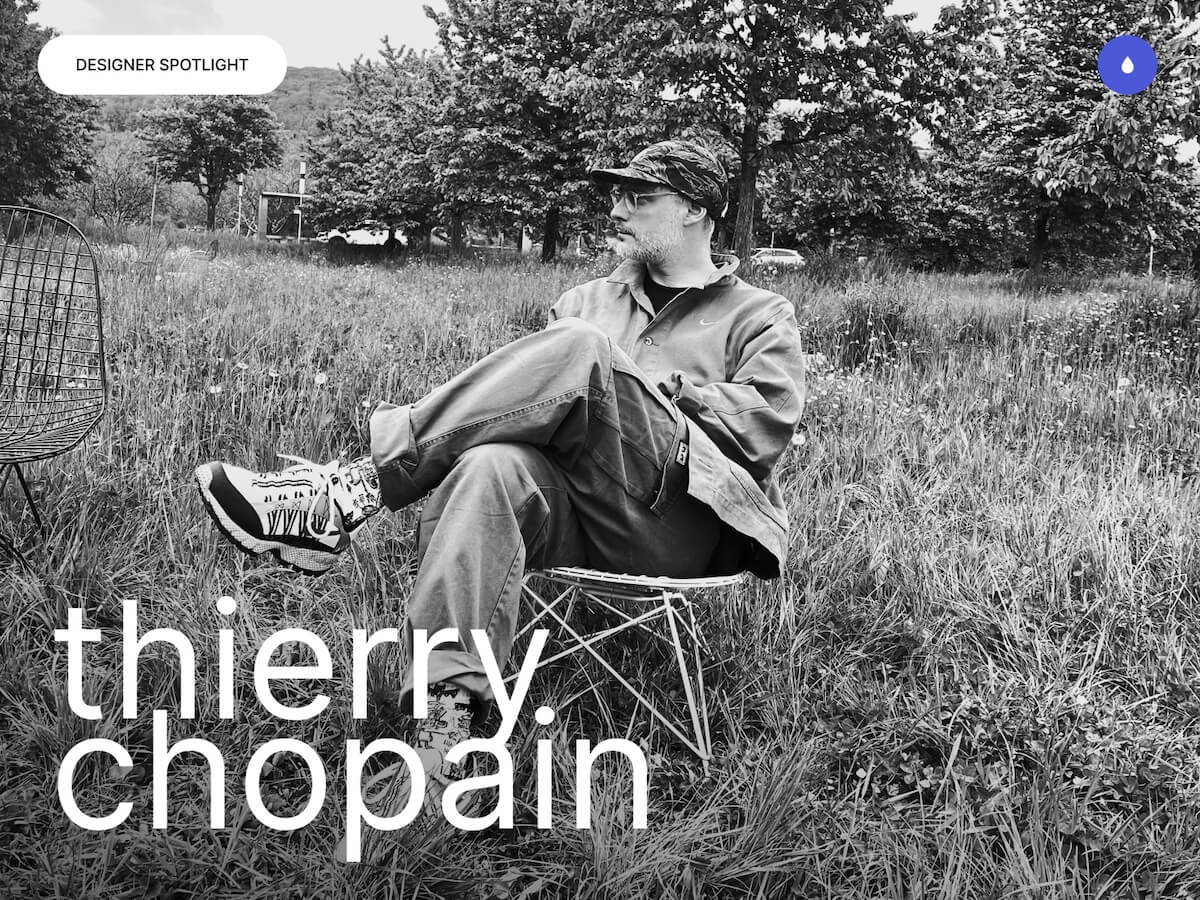
Hello I’m Thierry Chopain, a freelance interactive art director, co-founder of type8 studio and a UX/UI design instructor at SUP de PUB (Lyon).
Based near Saint-Étienne, I cultivate a balance between creative ambition and local grounding, between high-level design and a more human pace of life. I work remotely with a close-knit team spread between Lyon, Montpellier, and Paris, where we design custom projects that blend strategy, brand identity, and digital experience.
My approach is deeply collaborative. I believe in lasting relationships built on trust, mutual listening, and the value of each perspective. Beyond aesthetics, my role is to bring clarity, meaning, and visual consistency to every project. Alongside my design practice, I teach at SUP de PUB, where I support students not only in mastering UX/UI concepts, but also in shaping their path as independent designers. Sharing what I’ve learned on the ground the wins, the struggles, and the lessons is a mission that matters deeply to me.
My day-to-day life is a mix of slow living and agility. This hybrid rhythm allows me to stay true to my values while continuing to grow in a demanding and inspiring industry. I collaborate with a trusted network of creatives including Jeremy Fagis, Marine Ferrari ,Thomas Aufresne, Jordan Thiervoz, Alexandre Avram, Benoit Drigny and Olivier Marmillon to enrich every project with a shared, high-level creative vision.
Featured Projects
OVA INVESTMENT
It’s an investment fund built around a strong promise: to invest disruptively in the most valuable assets of our time. Type8 studio partnered collaboration with DEPARTMENT Maison de Création and Paul Barbin to design a fully reimagined website that lives up to its bold vision and distinctive positioning. Site structure, visual direction, tone of voice, and user experience were all redefined to reflect the strategic precision, elegance, and forward-thinking nature of the fund.
The goal of this project: Position OVA as a benchmark combining financial performance, innovation, and rarity, through refined design, a seamless interface, and custom development, in order to strengthen its credibility with a discerning audience and strategic partners.
Hocus Pocus Studio
Hocus Pocus is a Lyon based animation studio specialized in creation of CGI and visual effects for television, cinema and video game industry. The studio offer the best quality services with an always higher technical and artistic level of requirement. I worked on this project in collaboration with the Lyon-based studio AKARU which specializes in tailored and meticulously crafted projects.

The goal of this project: Develop a coherent and professional digital brand image that highlights visual effects, while boosting visibility and online presence to attract and inspire trust in customers.
21 TSI
21 TSI isn’t your typical sports holding company. Overseeing a portfolio of brands in the sports equipment space the team set out to break from the mold of the standard corporate website. Instead, they envisioned a digital experience that would reflect their DNA where innovation, design, and technology converge into a rich, immersive journey. We collaborated with DEPARTMENT Maison de Création and Paul Barbin to create something truly unique.
The goal of this project: A website that embodies the DNA of 21TSI: innovation, technology, minimalism. An immersive and aesthetic experience, a clean design, and an approach that explores new ways of engaging with sport through AI.
Teria
TERIA is a system that provides real-time centimeter-level positioning. It is an innovative tool that allows the localization and georeferencing. We set out to create an intuitive and innovative experience that perfectly reflects Teria’s precision and forward-thinking vision. A major part of the work focused on a clean, minimalist design that allows for smooth navigation making space to highlight the incredible work of Alexandre Avram, showcasing the products through Spline and 3D motion design.
The goal of this project: Develop a clear and professional digital brand that reflects the brand’s identity and values, showcases product innovation, and boosts visibility to build trust and attract customers.
Creating visual identities for musical artists
In a dense and ever-evolving music scene, standing out requires more than just great sound it also takes a strong and cohesive visual presence. Whether it’s the cinematic intensity of Lecomte de Brégeot, the raw emotion of Élimane my approach remains the same: to craft a visual universe that extends and enhances the essence of each artist, regardless of the medium.


I’m design visual identities, websites, and digital assets that combine bold aesthetics with clarity. The goal is to give each artist a unique space where their music, vision, and personality can fully come to life both visually and emotionally.
A Defining Moment in My Career
A turning point in my journey was the transition from working as an independent designer to founding a structured creative studio, type8 Studio. For more than ten years, I worked solo or within informal networks, juggling projects, constantly adapting, and learning how to shape my own freedom. That period gave me a lot—not only in terms of experience, but also in understanding what I truly wanted… and what I no longer wanted.
Creating a studio was never a predefined goal. It came together progressively, through encounters, shared values, and the growing need to give form to something more collective and sustainable. Type8 was born from this shared intention: bringing together skills and creative ambitions while preserving individual freedom.
This change was not a rupture but a natural evolution. I didn’t abandon my three identities—independent designer, studio art director, and educator. On the contrary, I integrated them into a more fluid and conscious ecosystem. Today, I can choose the most relevant role depending on the project: sometimes the studio takes the lead, sometimes it’s the freelance spirit that fits best, and at other times, it’s the educator in me who comes forward.
This hybrid model, which some might see as unstable, is for me a tailor-made balance, deeply aligned with how I envision work: adaptive, intentional, and guided by respect for the project’s purpose and values.
My Design Philosophy
I see design as a tool serving meaning, people, and impact beyond mere aesthetics. It’s about creating connection, clarity, and relevance between intention and users. This approach was shaped through my collaboration with my wife, an expert in digital accessibility, who raised my awareness of inclusion and real user needs often overlooked.
Today, I bring ethics, care, and respect into every project, focusing on accessible design and core human values: kindness, clarity, usefulness, and respecting user constraints. I prioritize human collaboration, tailoring each solution to the client’s context and values, even if it means going against trends. My design blends strategic thinking, creativity, and personal commitment to create enriching and socially valuable experiences.
Tools and Techniques
- Figma: To design, create, and gather ideas collaboratively.
- Jitter: For crafting smooth and engaging motion designs.
- Loom: To exchange feedback efficiently with clients.
Tools evolve but they’re just means to an end. What really matters is your ability to think and create. If you’re a good designer, you’ll know how to adapt, no matter the tool.
My Inspirations
My imagination was shaped somewhere between a game screen, a sketchbook. Among all my influences, narrative video games hold a special place. Titles like “The Last of Us” have had a deep impact on me not just for their striking art direction, but for their ability to tell a story in an immersive, emotional, and sensory way. What inspires me in these universes isn’t just the gameplay, but how they create atmosphere, build meaningful moments, and evoke emotion without words. Motion design, sound, typography, lighting all of it is composed like a language. And that’s exactly how I approach interactive design: orchestrating visual and experiential elements to convey a message, an intention, or a feeling.
But my inspirations go beyond the digital world. They lie at the intersection of street art, furniture design, and sneakers. My personal environment also plays a crucial role in fueling my creativity. Living in a small village close to nature, surrounded by calm and serenity, gives me the mental space I need to create. It’s often in these quiet moments, a walk through the woods, a shared silence, the way light plays on a path that my strongest ideas emerge.

I’m a creative who exists at the crossroads: between storytelling and interaction, between city and nature, between aesthetics and purpose. That’s where my work finds its balance.
Final Thoughts
For me, design has always been more than a craft it’s a way to connect ideas, people, and emotions. Every project is an opportunity to tell a story, to create something that feels both meaningful and timeless. Stay curious, stay human, and don’t be afraid to push boundaries. Because the most memorable work is born when passion meets purpose.
“Turning ideas into timeless experiences.”
Contact
Thanks for taking the time to read this article.
If you’re a brand, studio, or institution looking for a strong and distinctive digital identity. I’d be happy to talk whether it’s about a project, a potential collaboration, or just sharing a few ideas.

